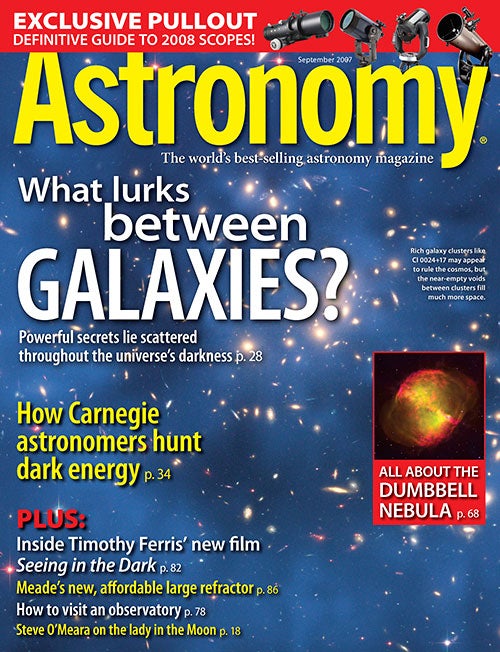
July 31, 2007
WAUKESHA, WI – More than half of the ever-expanding intergalactic medium (IGM) has yet to be accounted for. But according to Astronomy contributor Bruce Dorminey’s cover story, what we know may tell astronomers a lot about how galaxies formed and evolved.
Galaxies arrange themselves along the weblike filamentary structure surrounding such voids, forming clusters and superclusters of galaxies in dense knots where the filaments intersect.
“Voids fill a much larger fraction of the universe than clusters because, as the universe expands, the clusters contract while the voids grow,” says astrophysicist Michael Vogeley of Drexel University in Philadelphia.
“What lurks between galaxies?” explains how astronomers are zeroing in on these next-to-nothing voids. Unveil the IGM’s secrets this month in Astronomy!
Astronomy‘s September issue also includes the “Telescope buyer’s guide” – a 20-page exclusive pullout with everything you need to know about scopes for 2008. If you’re in the market for a new telescope, start here. Telescope reviewer Tom Trusock gives readers the lowdown on 39 refractors, reflectors, and compound scopes starting at just $200.
The September issue of Astronomy is available now on newsstands everywhere.
Supernova sleuths
“Will supernovae shine new light on dark energy?” That’s the question Astronomy Contributing Editor Bob Berman asks in the September 2007 issue. Berman goes behind the scenes at Carnegie Observatories to get the scoop on an unprecedented survey of exploding stars. Join Carnegie astronomers as they unravel the riddle of dark energy in their exploration of distant galaxies from Earth’s clearest skies.
Discover the Dumbbell
When French comet-hunter Charles Messier discovered the Dumbbell Nebula in 1764, he had no idea this object – one of the sky’s brightest planetary nebulae – foretold our Sun’s fate. Nearly 200 years later, astronomers realized our star would someday become an object similar to the Dumbbell. Raymond Shubinski, a contributing editor of Astronomy, presents this great sky showpiece in “All about the Dumbbell Nebula.”
Astronomy on film
Astronomy‘s September 2007 issue offers readers an inside look at author and filmmaker Timothy Ferris’ new film, Seeing in the Dark. Associate Editor Daniel Pendick describes Ferris’ greatest challenge in filmmaking: recreating the sights, sounds, and emotions of stargazing. “Watch Ferris’ film,” Pendick writes, “but don’t forget to look up afterward.”
Also in the September 2007 Astronomy:
• “Visit your friendly neighborhood observatory” – You don’t have to travel as far as you might think to get spectacular views through a telescope.
• “Meade’s affordable large refractor” – The LXD75 AR-6 AT achromat delivers high-quality performance.
• The September 2007 Astronomy also includes Ask Astro, Astro news, Bob Berman’s strange universe, Glenn Chaple’s observing basics, Phil Harrington’s binocular universe, Stephen James O’Meara’s secret sky, The sky this month, New products, and Reader gallery.









